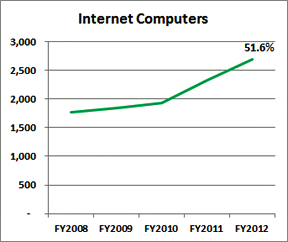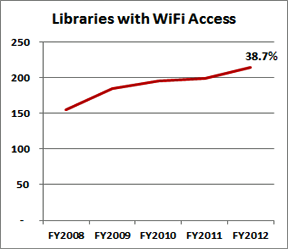Search the Blog
Categories
- Books & Reading
- Broadband Buzz
- Census
- Education & Training
- General
- Grants
- Information Resources
- Library Management
- Nebraska Center for the Book
- Nebraska Memories
- Now hiring @ your library
- Preservation
- Pretty Sweet Tech
- Programming
- Public Library Boards of Trustees
- Public Relations
- Talking Book & Braille Service (TBBS)
- Technology
- Uncategorized
- What's Up Doc / Govdocs
- Youth Services
Archives
Subscribe
Author Archives: John Felton
Data Doodles: New Statistics Edition
 Have you been looking for Nebraska public library statistics for the 2012-2013 fiscal year? Well, search no longer because they are now available on the Library Commission’s website at http://nlc.nebraska.gov/stats/. Scroll down to the Library Statistical Data section for links to:
Have you been looking for Nebraska public library statistics for the 2012-2013 fiscal year? Well, search no longer because they are now available on the Library Commission’s website at http://nlc.nebraska.gov/stats/. Scroll down to the Library Statistical Data section for links to:
- An Excel spreadsheet with the complete data from the FY 2013 Public Libraries Survey,
- A one-page summary of the annual data in Excel or Adobe Reader format,
- An updated Nebraska Public Libraries Directory with the latest data, and
- A Nebraska map with location markers and pop-up statistics for each public library
I want to thank to everyone who completed and submitted an annual library survey, because this statistical information would not be available without your hard work.
Preview of IMLS Public Library Statistics FY 2011
 Yes, it is 2014 now, but it takes a while to compile and verify all of the statistics from the 8,956 public libraries in the U.S., so the official 2010-2011 data has just been released. It’s worth a look, though, because there is more than just dry data in this report. There is a Fast Facts sheet that summarizes the data, there are profiles for each state (Nebraska’s is here), and there are five supplementary tables that examine select characteristics and show how the states rank in various categories. (Note: Yes, Nebraska has more than 216 libraries as shown in the profile, but we didn’t receive data from all of them.)
Yes, it is 2014 now, but it takes a while to compile and verify all of the statistics from the 8,956 public libraries in the U.S., so the official 2010-2011 data has just been released. It’s worth a look, though, because there is more than just dry data in this report. There is a Fast Facts sheet that summarizes the data, there are profiles for each state (Nebraska’s is here), and there are five supplementary tables that examine select characteristics and show how the states rank in various categories. (Note: Yes, Nebraska has more than 216 libraries as shown in the profile, but we didn’t receive data from all of them.)
You will discover that U.S. public libraries served 299.9 million people in FY 2011, which is 95.3% of the population. These people made over 1.5 billion visits to public libraries, attended 3.81 million programs, and borrowed 2.44 billions items. Read it! It’s a feel-good story for all people who work in public libraries!
Posted in Library Management, Uncategorized
Leave a comment
Data Doodles: Ebook Statistics
I recently found some interesting data about eBooks from the “Internet Waves” column in the Jan/Feb issue of Information Today.
4,350: the number of ebook titles made available by the average public library 1
76.3%: the percentage of public libraries in the U.S. that lend ebooks (57% in Nebraska) 2
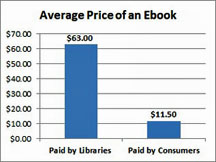 3.2: the average number of ebooks purchased per month by library ebook patrons 3
3.2: the average number of ebooks purchased per month by library ebook patrons 3
$11.50: the average consumer price for an ebook 4
$63.00: the average price of an ebook purchased by a library 4
- http://www.economist.com/news/international/21573966-e-books-mean-plot-twist-public-libraries-and-publishers-folding-shelves
- Hoffman, Judy, John Carlo Bertot, and Denise M. Davis. Libraries Connect Communities: Public Library Funding & Technology Access Study 2011-2012. Digital supplement of American Libraries magazine, June 2012. Available at http://viewer.zmags.com/publication/4673a369.
- http://www.overdrive.com/news/new-findings-reaffirm-library-borrowers-are-also-buyers/
- http://www.americanlibrariesmagazine.org/blog/year-ebook-price-comparisons-has-anything-changed
Posted in Books & Reading, General
Leave a comment
FCC Chairman Speaks at Library of Congress
![]() Yesterday, February 5, 2014, was National Digital Learning Day, which included an event at the Library of Congress. You will be interested in comments about libraries made by Tom Wheeler, Chairman of the Federal Communication Commission (FCC). Here are some excerpts from his speech.
Yesterday, February 5, 2014, was National Digital Learning Day, which included an event at the Library of Congress. You will be interested in comments about libraries made by Tom Wheeler, Chairman of the Federal Communication Commission (FCC). Here are some excerpts from his speech.
“During my tenure as Chairman of the FCC there may be no bigger and more significant issue than making sure our schools and libraries are connected to high-speed broadband networks. That is why E-Rate modernization is at the top of my agenda and why I support President Obama’s goal of connecting 99 percent of all students to high-speed broadband capacity in five years – or faster.”
“While we talk a lot about the connected school, we cannot overemphasize the crucial role of the connected library. Public libraries have been part of the fabric of America since our country’s founding. Thomas Jefferson, whose personal library was the founding collection of this great institution, described a library as, “a delivery room for the birth of ideas.” Today libraries are also something Mr. Jefferson could never have imagined: the community on-ramp to the world of information (although perhaps I misspeak, he was after all Thomas Jefferson!).
In community after community the library is the only place where students can go after school for free Internet access to complete their assignments. Research has found that a majority of American school children go to the public library to do school work. And for many of those students, it is the only link to the Net outside of school. That is really important when over 75% of K-12 teachers are assigning Internet-required homework. And during the summer, libraries are the only place for many students to go to continue their online exploration and learning. Libraries are also the only place where tens of millions of adult Americans can get access to the Internet for information on jobs, health care and government services.
The E-Rate is a program for schools and libraries. Or, let me put it another way: libraries and schools.”
You can read his complete presentation at http://fcc.us/1b36Aic.
Posted in General, Technology
Leave a comment
Data Doodles: Library Advocacy Edition
 Every year the Library Commission prepares for the Nebraska Library Association Advocacy Day by producing an infographic that shows, through the use of statistics, the value of public libraries in the state and how much they are used. You can download a copy of this year’s brochure by clicking on the graphic above.
Every year the Library Commission prepares for the Nebraska Library Association Advocacy Day by producing an infographic that shows, through the use of statistics, the value of public libraries in the state and how much they are used. You can download a copy of this year’s brochure by clicking on the graphic above.
Here are a few notable statistics from the brochure: Nebraskans used their public libraries 8,656,034 times in 2011-2012; the number of public access computers available at libraries increased by 15.5% last year; 79.5% of all Nebraska residents can download free e-books from their public library. Here’s another interesting fact I discovered recently. This January the ever popular Henry Doorly Zoo announced that their attendance for 2013 topped 1.6 million. About a week later, the Omaha Public Library issued a press release noting that the number of visits they received last year totaled almost 2.4 million.
Posted in General, Public Relations
Leave a comment
Data Doodles: Pew Library User Survey
 For this edition of Data Doodles, I looked at the survey of library users performed by the Pew Research Center in December of 2013; “How Americans Value Public Libraries in Their Communities.” On the positive side, 94% of respondents to the survey agreed that having a public library improves the quality of life in a community; 81% said that public libraries provide services many people would have a hard time finding elsewhere; and 72% of Americans ages 16 and over have either used a library or live in a “libr
For this edition of Data Doodles, I looked at the survey of library users performed by the Pew Research Center in December of 2013; “How Americans Value Public Libraries in Their Communities.” On the positive side, 94% of respondents to the survey agreed that having a public library improves the quality of life in a community; 81% said that public libraries provide services many people would have a hard time finding elsewhere; and 72% of Americans ages 16 and over have either used a library or live in a “libr ary household.” So, we know from this study that Americans believe public libraries are a valuable institution for their communities
ary household.” So, we know from this study that Americans believe public libraries are a valuable institution for their communities 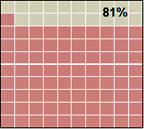 and that library usage is integrated into the family life of many citizens.
and that library usage is integrated into the family life of many citizens.
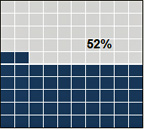 On the “we can do better” side, 52% of Americans say that people do not need public libraries as much as they used to because they can find most information on their own. It seems the belief that libraries have lost significance with the advent of the internet and the digital revolution persists in many people’s perception of the public library. When asked, “How well-informed do you feel about the different
On the “we can do better” side, 52% of Americans say that people do not need public libraries as much as they used to because they can find most information on their own. It seems the belief that libraries have lost significance with the advent of the internet and the digital revolution persists in many people’s perception of the public library. When asked, “How well-informed do you feel about the different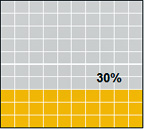 services and programs your public library offers?” 30% indicated that they didn’t know much or knew “nothing at all” about what their library offers. Also, 47% responded that they knew some of what the library offers. These results are almost exactly the same as a Pew survey from 2012. My conclusion from this response is that libraries still aren’t as effective as they could be in publicizing what they can offer to a community. This has been a persistent problem area for libraries throughout the nearly 4 decades I have been in the profession. So let’s keep trying out those marketing ideas we get from webinars and workshops.
services and programs your public library offers?” 30% indicated that they didn’t know much or knew “nothing at all” about what their library offers. Also, 47% responded that they knew some of what the library offers. These results are almost exactly the same as a Pew survey from 2012. My conclusion from this response is that libraries still aren’t as effective as they could be in publicizing what they can offer to a community. This has been a persistent problem area for libraries throughout the nearly 4 decades I have been in the profession. So let’s keep trying out those marketing ideas we get from webinars and workshops.
Posted in General, Library Management
Leave a comment
Data Doodles: Libraries are the Community’s Technology Hub
Nebraska libraries have been keeping up with the trend to become the community’s technology center by providing public internet computers and free wireless internet access. Check out the charts below for an illustration of the upward trend among libraries that submitted their annual Public Libraries Survey.
The actual figures of these two technology trends are 2,687 internet computers, or 1.85 for every 1,000 people served by a library. The number of public libraries now providing wireless internet connectivity has shot up to 215 or 80% of the state’s libraries.
Source: Nebraska Public Libraries Survey, FY 2008 through FY 2012.
Posted in General, Library Management, Technology
Leave a comment
Data Doodles: The Rise of Library Programming
Another public library performance measure that has seen significant growth in the past five years is the number of programs hosted by Nebraska libraries. From fiscal year 2008 through 2012, the number of programs increased by 21.6%. No one was speaking to an empty room, either, as attendance at these events grew by 22.8%.
This increase was undoubtedly influenced during the past two years by training sessions made possible by the Library Broadband Builds Nebraska Communities grant, but the trend was already established by the time the grant was awarded. This movement towards expanding the role of the library as a critical local service provider has certainly solidified the belief that public libraries should be recognized as community anchor institutions (CAI) along with schools, healthcare providers, government facilities, and other community support organizations.
Source: Nebraska Public Libraries Survey FY 2008 – FY 2012
Posted in General, Library Management
Leave a comment
Data Doodles: Rural Nature of Nebraska Public Libraries
Of the 93 counties in Nebraska, 80 have been designated as non-metropolitan.1
Within these rural counties there are 225 public libraries, or about 84% of the state’s 268 libraries. Among these rural libraries, 88% provide services to cities or villages with fewer than 5,000 residents. And within this group, 57% of the total number of Nebraska libraries serves a legal service area population of fewer than 1,000 residents.
The following table, based on locale categories devised by the U.S. Department of Education, provides a broad picture of how the majority of Nebraska’s public libraries serve small, rural communities.
|
Urban-centric |
Nebraska |
||
|
City |
Large: |
2 |
|
|
Midsize: |
0 |
||
|
Small: Territory inside an urbanized area and inside a principal city |
0 |
||
|
|
|
|
|
|
Suburb |
Large: |
5 |
|
|
Midsize: |
2 |
||
|
Small: Territory outside a principal city and inside an urbanized area |
0 |
||
|
|
|
|
|
|
Town |
Fringe: |
2 |
|
|
Distant: |
9 |
||
|
Remote: Territory inside an urban cluster that is more than 35 miles |
30 |
||
|
|
|
|
|
|
Rural |
Fringe: |
3 |
|
|
Distant: |
46 |
||
|
Remote: Census-defined rural territory that is more than 25 miles from |
169 |
||
|
Total |
268 |
||
|
Source: U.S. Department of Education, National Center for Education Statistics (NCES), Common Core of Data (CCD), Identification of Locale Codes, from http://nces.ed.gov/ccd/rural_locales.asp. |
|||
1 According to the “core-based statistical area” system used by the U.S. Office of Management and Budget.
Posted in General, Information Resources
Leave a comment
2013 Public Libraries Survey Ready for Submissions
The Nebraska Public Libraries Survey for the 2012-2013 fiscal year is now open and ready for data input. You can access the online survey form by going to http://collect.btol.com and entering your library’s user name and password. The survey is due on Friday, February 14, 2014.
The arrangement of the report has changed slightly and there are some additional questions and modifications to data elements this year, so you will want to check out the resources on the Library Commission’s Data Services page. Here you will find:
- A link to the Bibliostat Collect survey form,
- A blank copy of the survey for download that is useful for data collection prior to online entry,
- A Tip Sheet to help you complete the survey,
- Instructions for finding your Overdrive holdings and circulation statistics,
- Definitions of the data elements contained in the survey,
- And full instructions on completing the survey.
The information provided through this survey is used to determine accreditation status and state aid awards, so please be diligent in completing it accurately.
Posted in General, Library Management
Leave a comment
Data Doodle: Collection Spending Trends
For today’s doodle, I surveyed the 5-year trend in the amount Nebraska public libraries have been spending on print materials compared to electronic resources. The date range for the trend is fiscal year 2007/2008 through 2011/2012. The charts below illustrate how funds spent purchasing print materials have leveled off (-2.3%), while spending on electronic materials has risen sharply (+74.7%).
To analyze this trend another way: In FY 2008, 72% of collection expenditures went to print materials, but in 2012 this percentage had fallen to 67%. Spending on electronic resources in 2008 was 11.8% of collection budgets, but by 2012 the proportion of spending had risen to 19.7%. I’m certain this trend itself won’t surprise anyone in the library biz, but I was taken aback at the dramatic surge in spending on electronic resources.
BTW, this data was made possible by your participation in the annual Nebraska Public Libraries Survey, which begins again for the 2012-2013 fiscal year on November 18th.
Posted in General, Library Management
Leave a comment
Library Journal Star Libraries 2013
The Library Journal Index of Public Library Service for 2013 was just released and there are nine Nebraska libraries in the top-rated list. Four of these libraries have earned stars in every edition of the index since it began. They are shown in bold type in the table below.
|
Expenditure Category |
Stars |
Library |
City |
|
$10K-$49.9K |
***** |
Bloomfield Public Library |
Bloomfield |
|
$10K-$49.9K |
*** |
Creighton Public Library |
Creighton |
|
$10K-$49.9K |
***** |
Genoa Public Library |
Genoa |
|
$50K-$99.9K |
***** |
Hartington Public Library |
Hartington |
|
$50K-$99.9K |
*** |
Oakland Public Library |
Oakland |
|
$100K-$199.9K |
**** |
Atkinson Public Library |
Atkinson |
|
$100K-$199.9K |
***** |
Central City Public Library |
Central City |
|
$100K-$199.9K |
***** |
Neligh Public Library |
Neligh |
|
$200K-$399.9K |
*** |
Falls City Library and Arts Center |
Falls City |
The source of data for the index is the annual Public Libraries Survey, which is compiled by the Institute of Museum and Library Services (IMLS). The statistics for the 2013 index are from the FY 2011 survey.
Posted in General, Library Management
1 Comment
Data Doodles: Integrated Library Systems in Nebraska
Here are some quick facts about the number and distribution of integrated library systems (ILS) in Nebraska public libraries. This data is gleaned from the annual Public Libraries Survey, which revealed in the FY 2012 report that 174 libraries were using an automated library system product. See the chart below for details.
Posted in General, Library Management, Technology
2 Comments
2013 National Book Award Finalists Announced
After reviewing over 1,400 submissions, the judges for the National Book Awards have announced the finalists for 2013. The winners will be honored at an awards ceremony on November 20th, 2013. This year’s finalists include the following:
Fiction
- The Flamethrowers, by Rachel Kushner
- The Lowland, by Jhumpa Lahiri
- The Good Lord Bird, by James McBride
- Bleeding Edge, by Thomas Pynchon
- Tenth of December, by George Saunders
Nonfiction
- Book of Ages: The Life and Opinions of Jane Franklin, by Jill Lepore
- Hitler’s Furies: German Women in the Nazi Killing Fields, by Wendy Lower
- The Unwinding: An Inner History of the New America, by George Packer
- The Internal Enemy: Slavery and War in Virginia, 1772-1832, by Alan Taylor
- Going Clear: Scientology, Hollywood, & the Prison of Belief, by Lawrence Wright
Poetry
- Metaphysical Dog, by Frank Bidart
- Stay, Illusion, by Lucie Brock-Broido
- The Big Smoke, by Adrian Matejka
- Black Aperture, by Matt Rasmussen
- Incarnadine, by Mary Szybist
Young People’s Literature
- The True Blue Scouts of Sugar Man Swamp, by Kathi Appelt
- The Thing About Luck, by Cynthia Kadohata
- Far Far Away, by Tom McNeal
- Picture Me Gone, by Meg Rosoff
- Boxers and Saints, by Gene Luen Yang
Posted in Books & Reading, General
Leave a comment
Report: The State of Small & Rural Libraries
The Institute of Museum and Library Services (IMLS) just published a new brief, The State of Small and Rural Libraries in the United States. This report provides the agency’s first focused analysis of trends for rural and small library services. The sheer number of libraries in this category is one significant finding. Their research revealed that 77.1% of all public libraries are considered small and that 46 million people (that’s 15.4% of the population) are served by these libraries. This publication seems particularly relevant in this part of the country since this year’s conference of The Association for Rural & Small Libraries (ARSL) is currently being held in Omaha. Also significant, of course, is the fact that 58% of all public libraries in Nebraska serve populations of under 1,000.
Posted in General, Library Management
Leave a comment
Digital Inclusion Survey Starts September 3rd
Next week, libraries will begin receiving invitations to participate in a new national survey that will explore the digital inclusion roles of public libraries. These roles include:
- Providing public access computers and broadband connectivity
- Digital content, services, and accessibility
- Instruction in digital literacy
- Providing access to and assistance with essential online services and programs
This survey is critically important to provide data supporting the significant contributions public libraries make in developing digitally engaged communities. I know that fall makes the beginning of “survey season” and that you will soon be asked to complete the annual Public Libraries Survey as well, but this study will add to the body of evidence that libraries are essential community services, so please give it your attention.
The survey is managed by ALA and the University of Maryland Information and Policy and Access Center. Funding comes from the Institute of Museum and Library Services (IMLS), the International City/County Management Association (ICMA) and the ALA Office for Information technology Policy (OITP). For more information, read the ALA press release at http://bit.ly/19aGoR8 and visit the University of Maryland website at http://digitalinclusion.umd.edu/.
Posted in General, Library Management, Technology
Leave a comment
National FY 2011 Library Data Now Available
The Institute of Museum and Library Services (IMLS) announced today that the latest update of the Public Libraries Survey (FY 2010-2011) is now available on the IMLS Website. The research tool, Compare Public Libraries, has also been updated with this latest data. The official Public Libraries Survey report for 2011 will be published in the early fall of 2013.
Posted in Information Resources
Leave a comment
Create Online Forms to Collect Library Statistics
Our colleagues at the North Dakota State Library recently published a How-To guide on their blog, Field Notes, about using Google Docs to create online data collection forms. The two-part guide instructs librarians on how to design forms to tally statistics like library visits or reference transactions and then describes how to create reports for analysis and charts for data visualization.
I was quite impressed by this tutorial and thought that many libraries in Nebraska would be able to use this technique to keep track of usage data, especially those activities that are not collected by an automated library system. And, once these statistics are collected and compiled into reports, think how easy it would be to complete the annual Public Libraries Survey!
Posted in Education & Training, Library Management, Technology
1 Comment
Broadband Availability Improves in U.S.
I just read a blog post from the National Telecommunications and Information Administration (NTIA) that summarizes their report on broadband availability between 2010 and 2012. The report determined that basic broadband service is almost universal in urban areas and that while rural areas still lag behind, 91 percent of rural residents have access to broadband service as of June 2012.
NTIA’s Broadband Technology Opportunities Program (BTOP), which funded Nebraska’s three-year grant to improve library broadband service, has played a big part in expanding the availability of high-speed internet access for all citizens. The libraries participating in Nebraska’s BTOP program that received broadband access saw their average speed increase from 4.6Mbps to 24.4Mbps as of May 2013 and all 147 libraries in the program now offer wireless access for their customers.
Posted in General, Technology
Leave a comment
2012 Nebraska Public Libraries Survey Data Available
The results of the 2011/2012 Public Libraries Survey for Nebraska are now available for downloading on the Library Commission website. The full statistics are provided in Excel format or as a comma-delimited file. There is also a summary document of total figures that can be downloaded either in Excel or Adobe Acrobat format.
